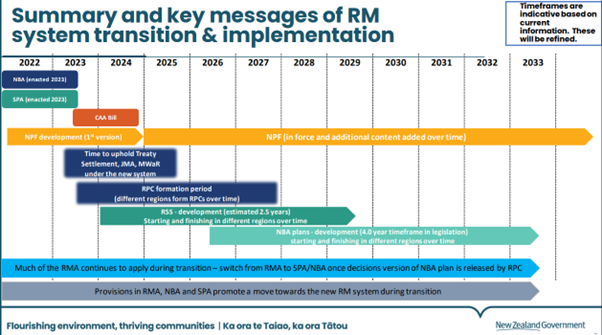Transitioning to the new resource management system
Topics covered in this article: RMA, RMA & Local Government
Senior Associate
Phone: +64 7 927 0595
Email: KStubbing@clmlaw.co.nz
LLB / BCom, University of Otago
Transitioning to the new resource management system – what happens next?
In this article we look ahead to the transition to the new resource management system. Submissions close on the Natural and Built Environment Bill (NBA Bill) and Spatial Planning Bill this month (February) and the Environment Select Committee is already deep into the detail of the bills.
The Select Committee is due to report back to Parliament on 22 May 2023 on both bills. We understand that Minister Parker’s intention to pass the bills into law this parliamentary term remains unchanged under new Prime Minister Chris Hipkins.
While the NBA Bill repeals and replaces the Resource Management Act 1991 (RMA), it will not happen overnight and the RMA will largely continue to govern day to day resource consenting and land development for many years. Overall the transition to the new system is anticipated to take 7 - 10 years, but this will be different from region to region.
The figure below from MfE documents[1] illustrates the anticipated timeframes of the transition to and implementation of the new resource management system.
While some of the detail of the proposed transitional arrangements is not included in the bills as introduced, clause 2 of the NBA Bill sets out which provisions of the new legislation will come into force on the day after the Bill receives Royal Assent. The main provisions relate to the purpose and preliminary matters, National Planning Framework (NPF), existing use rights, freshwater farm plans, and the ability for regulations to be introduced in relation to compliance and monitoring.
A notable timeframe is the requirement for the Minister to notify the first NPF within 6 months of the NBA coming into force and the NPF is anticipated to be in force by the end of 2024. We understand that MfE is already working on the NPF and receiving feedback from stakeholder groups on the overarching layer of the NPF, te Oranga o te Taiao, and managing potential conflicts between environmental outcomes.
In the period from NBA/SPA enactment until a region has a ‘decisions version’ of an NBA plan, much of the RMA will continue to apply, including:
- RMA national direction will remain in force. This will continue directing RMA plans and plan changes as well as consent decisions on the ground
- RMA regional and district plans will remain in place to provide a regulatory framework
- many RMA processes will remain in place (e.g. plan change processes and consent processing provisions)
- the NPF and Regional Spatial Strategy (RSS) will not explicitly direct RMA plans or consents
While the RMA will continue to apply during the gradual shift to the new system, it is important to note that the NBA Bill provides that:
- freshwater related permits[2] applied for and granted after enactment and before an NBA plan decisions version is released will expire three years after notification of an NBA plan unless an exemption applies[3]. The exemptions include council water supply networks, certain hydro-electric schemes and certain infrastructure activities
- for new RMA national direction developed after enactment of the NBA but during the transition, the Board of Inquiry and the Minister are required to consider the desirability of consistency with the NBA, through a combined RMA national direction/NPF development process provided for in Schedule 1
- a streamlined process will be provided for the Minister to amend RMA national direction provisions if they are redundant in the context of the system transition, or more efficiently addressed through new system instruments
We also understand that, while not currently included in the bills, it is MfE’s intention[4] that:
- RMA 10-year plan reviews will not be required to commence after enactment of the bills
- Most RMA plan changes will not be able to proceed after a Regional Planning Committee (RPC) has adopted its RSS
- RMA plan changes notified after RSS notification must not be inconsistent with the RSS, and must also have regard to limits and targets under the NPF and RSS
- Section 104(1)(c) of the RMA would allow decision makers to consider new system instruments such as an RSS (but would not force particular outcomes and the RMA decision making framework would continue to apply)
In short, the transition to the new resource management system will be complex and take some time and we expect there will be confusion and uncertainty during this period. During the transition the RMA will largely continue to apply including consenting under the regional and district planning documents that we have today. The limits on the duration of applications for water consents is an important exception. When decisions (by the RPC) are notified on the new Natural and Built Environment Plan for each particular region, the existing RMA documents will fall away.
We are closely following the bills as they progress through Parliament. If you have any questions on the bills or what the proposed transitional provisions could mean for you, please contact a member of our team.
[1] https://www.parliament.nz/resource/en-NZ/53SCEN_ADV_129831_EN10657/a3b08778e7e2b570ea99f3280d059bdecbd6e8c3.
[2] This includes RMA water permits, discharge permits and s15 land use consents for discharges to water.
[3] NBA Bill: Schedule 15, Part 3 (amendment to the RMA to be inserted in RMA Schedule 12).
[4] https://www.parliament.nz/resource/en-NZ/53SCEN_ADV_129831_EN10659/bdb4aa20c6db36bdbdd3cf946ec7d9fe7e8c29a6.
Latest Update: 2 February 2023






